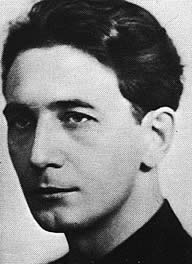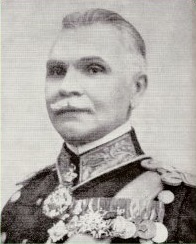Romania is a European country with a multicultural music environment which includes active ethnic music scenes. Romania also has thriving scenes in the fields of pop music, hip hop, heavy metal and rock and roll. During the first decade of the 21st century some Europop groups/artists, such as Tom Boxer, Morandi, Akcent, Edward Maya, Alexandra Stan, Inna and Yarabi, achieved success abroad. Traditional Romanian folk music remains popular, and some folk musicians have come to national fame.

Râmnicu Vâlcea is the capital city of Vâlcea County, Romania.

Horia Sima was a Romanian fascist politician, best known as the second and last leader of the fascist paramilitary movement known as the Iron Guard. Sima was also the commander of the associated Romanian Legionnaire Movement, an organization inspired by the model of the Nazi Sturmabteilung and Schutzstaffel organizations, the vice president of the council of ministers in Ion Antonescu's National Legionary State, and a short-lived minister in the government of Ion Gigurtu. In January 1941, Sima initiated and led the Legionnaires' Rebellion against Conducător Ion Antonescu and the Romanian Army, for which he was sentenced to death, as well as the Bucharest pogrom, the largest and most violent pogrom against Jews in the history of Muntenia. Following the rebellion, Sima escaped to Germany.

Gheorghe Argeșanu was a Romanian cavalry general and politician who served as a Prime Minister of Romania for about a week in 1939.

Făgăraș Mountains, are the highest mountains of the Southern Carpathians, in Romania. The highest peaks are:

DN7 is a national road in Romania which links Bucharest with the Banat region, in western Romania, and further to the eastern European capitals Budapest and Belgrade. It is a high-traffic road and the preferred route for trucks. Near Râmnicu Vâlcea the road crosses the Southern Carpathians along the Olt river, through the Valea Oltului touristic region. On its first segment, Bucharest - Piteşti, the road is doubled by the A1 motorway.

Drumul Taberei is a neighbourhood located in the south-west of Bucharest, Romania, roughly between Timișoara Avenue and Ghencea Avenue, neighboring Militari to the north, Panduri to the east and Ghencea and Rahova to the south and south-east.

Hărman is a commune in Brașov County, Romania. It is composed of two villages, Hărman and Podu Oltului (Vámoshíd). The commune is located some 10 km east of Brașov, in the Burzenland region of southeastern Transylvania.
The RATB route 105 Valea Oltului-Piaţa Presei Libere connects the south part of Bucharest with the north part via Gara de Nord. The line has more than 30 bus stations.

Vlad VII Vintilă de la Slatina was a Wallachian nobleman who reigned as the principality's voivode from 1532 to 1535. He was assassinated during a hunting expedition near Craiova.
Podu starts off the names of several places in Romania. It is also a traditional system of cultivation used by tribes in India, whereby different areas of jungle forest are cleared by burning each year to provide land for crops.

Peter the Younger was the Voivode (Prince) of Wallachia between 25 September 1559 and 8 June 1568. The eldest son of Mircea the Shepherd and Doamna Chiajna, his named "the Young" because, at the moment of crowning, he was only 13.

Țara Făgărașului is a region is southern Transylvania, Romania. Its main city is Făgăraș. On the north, it is bordered by the Olt River, while the region of Wallachia is to the south. In the Kingdom of Hungary and in Greater Romania, it corresponded to the counties of Fogaras and, respectively, Făgăraș. Today, it is divided between Brașov and Sibiu counties.

Traian Herseni was a Romanian social scientist, journalist, and political figure. First noted as a favorite disciple of Dimitrie Gusti, he helped establish the Romanian school of rural sociology in the 1920s and early '30s, and took part in interdisciplinary study groups and field trips. A prolific essayist and researcher, he studied isolated human groups across the country, trying to define relations between sociology, ethnography, and cultural anthropology, with an underlying interest in sociological epistemology. He was particularly interested in the peasant cultures and pastoral society of the Făgăraș Mountains. Competing with Anton Golopenția for the role of Gusti's leading disciple, Herseni emerged as the winner in 1937; from 1932, he also held a teaching position at the University of Bucharest.

Gheorghe Chițu was a Wallachian, later Romanian lawyer and politician.

Rupea Citadel is one of the oldest archaeological sites in Romania, the first signs of human settlements dating from the Paleolithic and early Neolithic.
Augustin Bunea was an Austro-Hungarian ethnic Romanian historian and priest within the Romanian Greek-Catholic Church.
Constantin Dumitrescu was a Romanian general.













